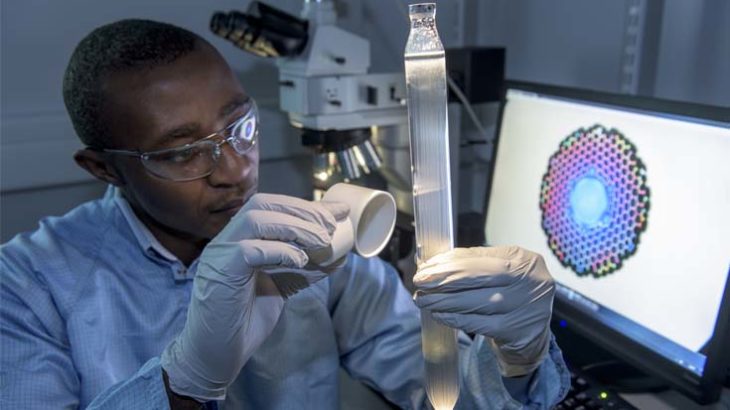Fibre-optics World Record is No Hollow Victory

A whole array of game-changing, life-shaping technologies, from long-distance telecommunications to laser surgery, have a key component in common: fibre optics that carry pulses of light to their destination at incredible speed.
A University of Southampton team are now focusing on the next big step forward – hollow-core fibres (HCFs) – and last year shattered a longstanding world record to push the capabilities of these to a new level.
Developing HCFs and readying them for real-world use is the mission of the £6 million AirGuide Photonics programme, led by Southampton and involving a high-powered consortium of industrial and academic partners, including fellow SES member UCL.
Revolution in the Air
Fibre optics is one of those technologies that not just our entire way of life but also our prospects for future progress are fundamentally underpinned by. Billions of miles of fibre-optic cable criss-cross the globe, vital arteries carrying colossal volumes of data as pulses of light, while the technology also plays a key role in an abundance of other applications, from medical endoscopes to laser-based manufacturing.
But today’s fibres, guiding light through a core of ultra-pure glass or plastic just one-fifth the width of a human hair, have frustrating limitations. Significant losses in signal speed and strength mean the search is on for an alternative that can keep pace with relentlessly rising demand in terms of fibre optics’ capacity and capability.
“Our vision is a new generation of technology – what we like to call ‘fibres 2.0’”–
Professor David Richardson, ORC
Could the answer be to get rid of the solid core and leave the space empty, filled only with air, a vacuum or, for specialist applications, gas? First proposed at Southampton in the mid-1990s, HCFs offer an appealing range of potential advantages. Guided through the hollow fibre using reflective internal microstructures, pulses can travel unimpeded at the speed of light and significant reductions in signal losses can be achieved, while higher-power signals can be transmitted because there’s no risk of damaging the core.

HCF technology is now powering ahead, with the AirGuide Photonics programme right at the cutting edge. Professor David Richardson of Southampton’s Optoelectronics Research Centre (ORC) is leading this 6-year EPSRC-funded initiative: “It’s about ground-breaking work delivered by a world-class team that combines skills here at the ORC with those of a 25-strong consortium,” he says. “Our vision is a new generation of technology – what we like to call ‘fibres 2.0’ – that will make solid fibres obsolete in many key application areas. Our focus is on developing best-in-class HCFs and passing the technology on to those who can harness it to reshape the world.”
Loss Leader
The programme’s primary value is that it represents a consolidated activity offering the breadth, depth and scale of expertise and resource needed to propel HCF technology towards successful real-world applications. As such, it provides the perfect platform for ongoing development of an array of fibre-optic breakthroughs achieved at Southampton.

A striking example revolves around an innovative type of HCF known as a NANF (Nested Antiresonant Nodeless HCF). Invented at the ORC, NANFs incorporate a fibre structure specifically designed to cut optical-signal losses. “12 tiny glass capillaries are carefully positioned around a hollow pipe that the light is guided through,” says Professor Francesco Poletti, who has been at the forefront of NANF development. “This reduces the amount of signal scattering. NANFs are also much easier to manufacture than other kinds of HCF.”
Last year, as part of a joint initiative between the European-funded LightPipe programme and ORC spinout Lumenisity, Francesco and his colleagues achieved a major milestone by using NANF technology to achieve the lowest-ever optical signal loss in a data-transmitting HCF – breaking the previous world record which had reigned supreme for 15 years.
“The ability to cut signal losses and boost transmission speeds is hugely important to efficient operation”–
Professor Francesco Poletti, ORC
Reaching for the Real World
This passion to drive promising technologies towards actual applications is one of the programme’s key characteristics. That’s why the consortium’s huge academic firepower is complemented by some of the biggest names in technology, such as Microsoft and BT. “Our industrial partners offer vital knowledge on key practical concerns that the technologies we’re developing will have to accommodate,” David Richardson notes. “Our work is about much more than setting records in a lab. By the time the initiative concludes in 2023, our goal is to ensure that practical applications of HCFs are on the verge of realisation, both in traditional fields and in newer areas such as use in gas-detecting sensors.”
Microsoft, for instance, are making an important contribution to an AirGuide Photonics collaboration between Southampton and UCL’s Optical Networks Group. The aim is to develop HCFs for use in the high-capacity optical communications networks and hyper-scale data centres that will be critical to keeping pace with ferocious growth in data volumes and digital demand that the years and decades ahead look certain to see.
“We’re using two of our state-of-the-art testbeds to make important advances,” says UCL’s Dr Zhixin Liu. “For example, we’ve set a new HCF record for data transmission of 6.6 terabits per second. To support our work, Microsoft provide us with anonymised data on user requests, analyses of data traffic from their data centres, and technical insights into the operations of data-centre networks. This kind of collaboration is absolutely key to ensuring that HCF technology will be equal to the challenge of responding to industry’s demands and society’s aspirations in future. It’s a very challenging and exciting time for fibre optics.”
Further Information
- Record Low-Loss 1.3dB/km Data Transmitting Antiresonant Hollow Core Fibre
- Beyond Standard Fibre: Exploring the Potential of Hollow Core Fibre
- Sub-Nanosecond Clock and Data Recovery in an Optically-Switched Data Centre Network
- Nonlinearity-free Coherent Transmission in Hollow-Core Antiresonant Fiber
Featured image:
AirGuide’s Dr Eric Numkam Fokoua inspecting a Photonic Band Gap Fibre preform for imperfections
Footnotes


